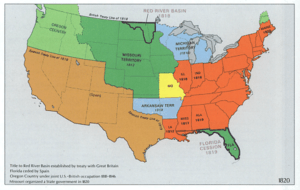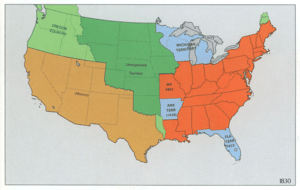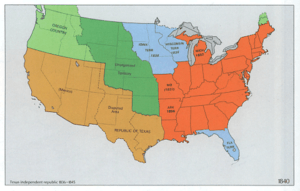Timeline of United States history (1820–1859) facts for kids
This part of the Timeline of United States history looks at important events in the United States from 1820 to 1859. During these years, the country grew a lot, adding new states and expanding its borders. It was a time of big changes, new inventions, and important decisions about the future of the nation, especially concerning slavery.
Contents
The 1820s: Growth and New Ideas
1820s in the United States: 1820, 1821, 1822, 1823, 1824, 1825, 1826, 1827, 1828, 1829.
Presidents of the 1820s
James Monroe's Time as President
- 1820 – Maine became a new state, separating from Massachusetts.
- 1820 – James Monroe was reelected president without anyone running against him. Daniel D. Tompkins was reelected vice president.
- 1821 – President Monroe and Vice President Tompkins started their second terms.
- 1821 – Missouri became a state.
- 1821 – Florida became a U.S. territory after a treaty with Spain.
- 1823 – The Monroe Doctrine was announced. This policy warned European countries not to try and create new colonies in the Americas.
- 1824 – A Supreme Court case, Gibbons v. Ogden, said that the federal government had more power than states when it came to trade between states.
- 1824 – The presidential election was very close, and no one won enough votes. John C. Calhoun was elected vice president.
- 1825 – The House of Representatives chose John Quincy Adams as president.
John Quincy Adams's Time as President
- 1825 – Adams became the sixth President, with John C. Calhoun as Vice President.
- 1825 – The Erie Canal was finished. This important waterway connected the Great Lakes to the Atlantic Ocean, making trade easier.
- 1826 – Two former presidents, Thomas Jefferson and John Adams, both died on the same day. This was exactly 50 years after the Declaration of Independence was approved.
- 1828 – Andrew Jackson was elected president. John C. Calhoun was reelected vice president.
- December 22, 1828 – The future First Lady, Rachel Jackson, died.
Andrew Jackson's First Term
- 1829 – Andrew Jackson became the seventh President. Vice President Calhoun began his second term.
The 1830s: Big Changes and Conflicts
1830s in the United States: 1830, 1831, 1832, 1833, 1834, 1835, 1836, 1837, 1838, 1839.
- 1830s – The Second Great Awakening was a period of religious revival across the country.
- 1830s – The Oregon Trail began to be used by settlers traveling to the Pacific Northwest.
- 1830 – The Indian Removal Act was passed. This law allowed the government to force Native American tribes to move west.
- 1831 – Nat Turner led a slave rebellion.
- 1831 – The Liberator, an anti-slavery newspaper, started being published.
- 1831 – Cyrus McCormick invented the mechanical reaper, a machine that made harvesting crops much faster.
- 1832 – In the Worcester v. Georgia case, the Supreme Court ruled that the Cherokee Nation was a separate community. However, President Jackson did not follow this ruling.
- 1832 – Maria W. Stewart became the first Black American woman to give a public speech to an audience of both men and women.
- 1832 – The Black Hawk War took place.
- 1832 – A new Tariff of 1832 was passed, which led to South Carolina passing the Ordinance of Nullification. This ordinance said the state would not follow the federal tariff law.
- 1832 – The Department of Indian Affairs was created.
- 1832 – Andrew Jackson was reelected president. Martin Van Buren was elected vice president.
- 1832 – Jackson stopped the charter for the Second Bank of the United States, which led to a financial crisis later.
- 1832 – John C. Calhoun resigned as vice president.
- 1833 – The Force Bill was passed, giving the president more power to enforce federal laws.
- 1833 – President Jackson began his second term, with Martin Van Buren as Vice President.
- 1834 – Important discussions about slavery happened at Lane Seminary.
- 1835 – The Mexican President, Santa Anna, changed Mexico's constitution. This led to a civil war and the Texas Revolution.
- 1835 – The book Democracy in America by Alexis de Tocqueville was published, describing American society.
- 1835 – The Second Seminole War began in Florida as the Seminole tribe resisted being moved from their lands.
- 1836 – Santa Anna's army defeated Texas rebels at the Battle of the Alamo.
- 1836 – The Battle of Goliad took place.
- 1836 – Santa Anna was removed from power after losing the Battle of San Jacinto and recognizing Texas's independence.
- 1836 – The Creek War of 1836 occurred.
- 1836 – Samuel Colt invented the revolver, a type of handgun.
- 1836 – The first "gag rule" was put in place in the U.S. House of Representatives. This rule stopped discussions about anti-slavery petitions.
- 1836 – The Specie Circular was issued, requiring payment for public lands in gold or silver.
- 1836 – Arkansas became a state.
- 1836 – Texas became the independent Lone Star Republic.
- 1836 – Martin Van Buren was elected president. No one was elected vice president by the people.
- 1837 – Richard Mentor Johnson was elected vice president by the Senate.
Martin Van Buren's Time as President
- 1837 – Van Buren became the eighth President, with Johnson as Vice President.
- 1837 – The U.S. officially recognized the Republic of Texas.
- 1837 – The Caroline affair caused tension with Great Britain.
- 1837 – Michigan became a state.
- 1837 – Oberlin College started allowing female students, becoming one of the first coeducational colleges in the U.S.
- 1837 – The Panic of 1837 was a major economic crisis.
- 1837 – The Supreme Court case Charles River Bridge v. Warren Bridge ruled that public needs could sometimes be more important than private property rights.
- 1838 – The forced removal of the Cherokee Nation from the southeastern U.S. happened, known as the Trail of Tears. Over 4,000 people died during this journey.
- 1838 – The Aroostook War was a dispute over the border with Canada.
- 1839 – The Amistad case began, involving enslaved Africans who rebelled on a ship.
The 1840s: Expansion and Conflict
1840s in the United States: 1840, 1841, 1842, 1843, 1844, 1845, 1846, 1847, 1848, 1849.
- 1840 – William Henry Harrison was elected president, and John Tyler was elected vice president.
- 1841 – John Quincy Adams argued the Amistad case before the Supreme Court.
William Henry Harrison's Time as President
- March 4 – Harrison became the ninth President, with John Tyler as Vice President.
- March 6 – The Supreme Court ruled in favor of the Amistad defendants, freeing them.
- April 4 – Harrison died after only one month in office, becoming the first U.S. president to die in office.
John Tyler's Time as President
- April 6, 1841 – Vice President Tyler became the tenth President.
- September 11, 1841 – Most of Harrison's cabinet resigned.
- 1842 – The Webster–Ashburton Treaty settled border disputes with Great Britain.
- 1842 – The Dorr Rebellion was a conflict over voting rights in Rhode Island.
- 1843 – An attempt to remove President Tyler from office failed.
- 1843 – More emigrants began their journey along the Oregon Trail.
- 1844 – James K. Polk was elected president, and George M. Dallas was elected vice president.
- 1845 – Texas annexation occurred, making Texas part of the United States.
James K. Polk's Time as President
- 1845 – Polk became the 11th President, with Dallas as Vice President.
- 1845 – Florida and Texas became states.
- 1846 – The U.S.–Mexican War began.
- 1846 – The Bear Flag revolt happened in Alta California, leading to a short-lived independent republic.
- 1846 – Iowa became a state.
- 1846 – The Wilmot Proviso was proposed, aiming to ban slavery in any new territories gained from Mexico.
- 1846 – The United States and Great Britain signed the Oregon Treaty, settling the border in the Pacific Northwest.
- 1847 – Abraham Lincoln became known for his "Spot Resolutions" in the House, questioning the start of the Mexican-American War.
- 1847 – The Battle of Buena Vista and the Battle of Veracruz were important battles in the Mexican-American War.
- 1848 – Wisconsin became a state.
- 1848 – The Treaty of Guadalupe Hidalgo ended the Mexican-American War. The U.S. gained a large amount of land from Mexico.
- 1848 – Dred Scott sued for his freedom, starting a long legal battle.
- 1848 – Zachary Taylor was elected president, and Millard Fillmore was elected vice president.
Zachary Taylor's Time as President
- 1849 – Taylor became the 12th President, with Fillmore as Vice President.
- 1849 – The California Gold Rush began, bringing many people to California hoping to find gold.
The 1850s: Growing Tensions
1850s in the United States: 1850, 1851, 1852, 1853, 1854, 1855, 1856, 1857, 1858, 1859.
- 1850 – The Clayton–Bulwer Treaty was signed with Great Britain, concerning a possible canal across Central America.
- 1850 – President Taylor threatened to veto the Compromise of 1850.
- June 3–11 – The Nashville Convention was held in Tennessee, where some southern states discussed leaving the Union.
Millard Fillmore's Time as President
- July 9, 1850 – President Taylor died, and Vice President Fillmore became the 13th President.
- September 9–20, 1850 – The Compromise of 1850 was passed. This set of laws tried to calm tensions over slavery, but it also included the strict Fugitive Slave Act.
- September 9, 1850 – California became a state.
- November 1850 – The Nashville Convention met again and decided to stay in the Union for the time being.
- 1852 – Franklin Pierce was elected president, and William R. King was elected vice president.
- 1853 – Commodore Matthew Perry opened Japan to trade with the U.S.
Franklin Pierce's Time as President
- Further information: Bleeding Kansas
- 1853 – Pierce became the 14th President, with King as Vice President.
- 1853 – Vice President King died just six weeks after taking office.
- 1853 – The Gadsden Purchase added more land to the U.S. from Mexico.
- 1854 – The Kansas–Nebraska Act was passed. This law allowed people in new territories to decide if they wanted slavery, which effectively ended the Missouri Compromise. This led to violence in Kansas.
- 1854 – The Ostend Manifesto was a secret document suggesting the U.S. should buy or take Cuba from Spain.
- 1854 – The Whig Party collapsed.
- 1854 – The Treaty of Kanagawa was signed with Japan.
- 1854 – William Walker led an expedition into Nicaragua.
- 1855 – The Farmers' High School, which later became Penn State University, was founded.
- 1856 – The Sack of Lawrence, Kansas was a violent attack by pro-slavery forces.
- 1856 – The Pottawatomie massacre was a violent act by anti-slavery forces.
- 1856 – The Preston Brooks beat Charles Sumner with a cane in the U.S. Capitol building due to a speech Sumner gave about slavery.
- 1856 – James Buchanan was elected president, and John C. Breckinridge was elected vice president.
James Buchanan's Time as President
- 1857 – Buchanan became the 15th President, with Breckinridge as Vice President.
- 1857 – The Dred Scott v. Sandford Supreme Court case ruled that enslaved people and their descendants were not U.S. citizens and could not sue in federal court. It also said Congress could not ban slavery in territories.
- 1857 – The Utah War occurred.
- 1857 – The Lecompton Constitution, which would have allowed slavery in Kansas, was rejected.
- 1857 – The Panic of 1857 was another economic downturn.
- 1857 – The Minns Evening Normal School was established in San Francisco, which later became San Jose State University.
- 1858 – The first transatlantic cable was laid, allowing messages to be sent across the Atlantic Ocean.
- 1858 – Minnesota became a state.
- 1858 – The Lincoln-Douglas Debates were a series of famous debates between Abraham Lincoln and Stephen Douglas about slavery.
- 1858 – The U.S. was part of the Treaty of Tientsin with China.
- 1859 – John Brown's raid on Harpers Ferry was an attempt by an abolitionist to start a slave rebellion.
- 1859 – The Comstock Lode, a huge silver deposit, was discovered.

All content from Kiddle encyclopedia articles (including the article images and facts) can be freely used under Attribution-ShareAlike license, unless stated otherwise. Cite this article:
Timeline of United States history (1820–1859) Facts for Kids. Kiddle Encyclopedia.



